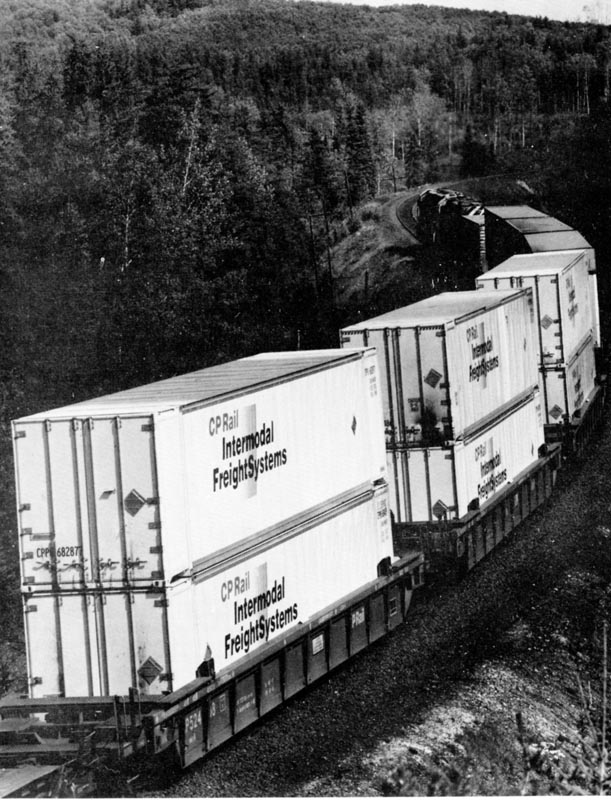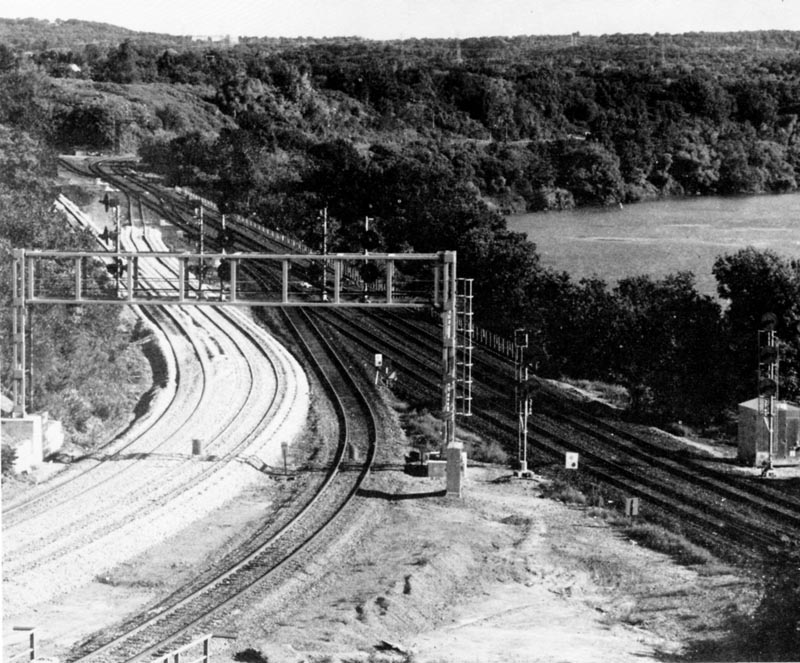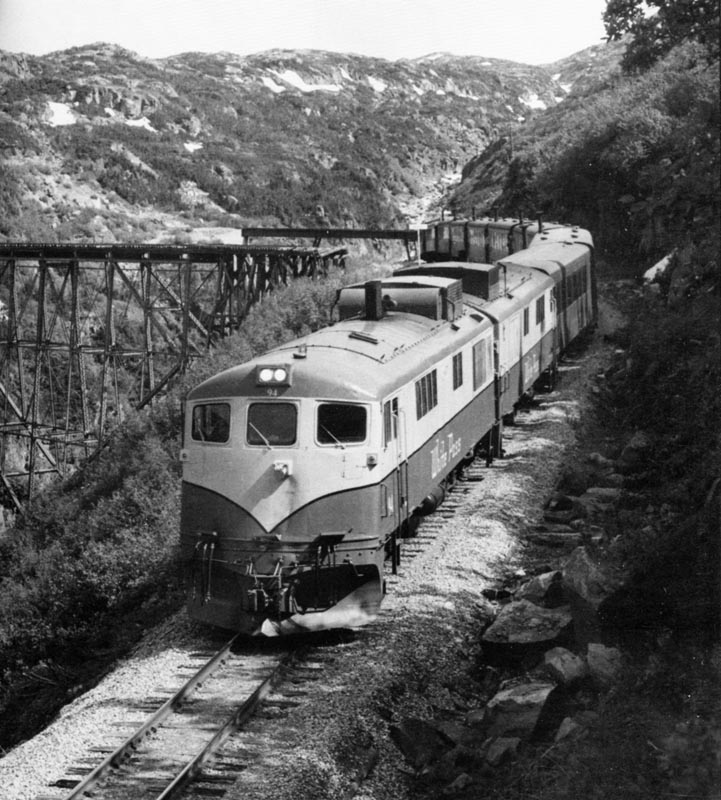
|
Historical
Category Winner - James A Brown
 It's
Monday, the last day
of 1961 but one, business is slow at CP's usually hectic West Toronto
Diamond, and operator Art Simmons takes an opportunity to catch up on a
little reading between trains. West Toronto's operator took care of
train orders for the Mactier Sub (to the north), while its leverman
handled the signals and switches controlling passing movements on CPR's
Gait, North Toronto and Mactier Subs, not to mention CN's Brampton Sub.
which crossed through the middle of everything. Photo by James A. Brown.
One look at this picture and it quickly becomes apparent that the photographer has skilfully succeeded in delivering a thoughtful and technically impressive snapshot of railroading, as it existed back in the days before the modern electronic revolution. This well balanced and sharply focused photograph captures the rich atmosphere of a key railway facility during a much appreciated lull in the action. While clearly placing the operator at the focal point in the picture, the uniform lighting puts appropriate emphasis on both the human and mechanical elements of the scene. The switch-levers are prominently retained as a means of framing the central figure, in part contributing to an overall sense of purpose. The dispatcher's phone and head-set, the dangling light bulb complete with tattered shade, even the ergonomically inferior hardwood swivel-chair, all combine to make this a truly captivating look back at the past. It's easy for the viewer to imagine him or herself near the top of the stairway leading to the tower's upper level, getting a first hand look at all of the marvellous detail that surrounds the camera's eye.  Freight Train Category Winner - A. Ross
Harrison
If circumstances call for a bold photographic statement to
aptly profile the modern freight train of the nineties, then what
better expression exists than a string of gleaming double-stack
containers, snaking their way through the Canadian wilderness. Good
side lighting and an excellent elevated line of sight successfully
captures the passing action in a frozen instant. The bright intermodal
equipment contrasts well with the darker tonal qualities of the forest
that carpets the background all the way to the distant horizon.
Cleverly, the camera's perspective gently draws the viewer's eye away
from the immediate scene, down past the locomotives and through the
remainder of the S-curve. In doing so, one gets an opportunity to
experience all the detail the CP Rail System Extra 5716 East (472's train) coils through the reverse curves approacning O'Brien (Ontario) on the White River Subdivision on August 24, 1994. Photo by Ross Harrison. scene has to offer. The fact that the head-end power plays a minor supporting role in the photograph, in no way detracts from the picture's over-all purpose, that being to showcase today's versatile road to rail capability. So often, maybe even too much so, the measure of a successful track-side photo is weighted in favour of having that perfect frontal wedge shot of an approaching train, with the locomotives stealing the entire scene. Invariably good photographic opportunities are missed, or on occasion intentionally ignored. Thanks to our photographer's efforts we are skilfully reminded to have an eye for that often rewarding shot behind the shot.  Miscellaneous Category Winner - Martin
Galley
On August 24, 1995, construction
is nearly complete at Hamilton Junction (Ontario) where a new bridge
has been built to carry the line in the centre foreground towards
Hunter Street in Hamilton for future expanded GO train service. The CP
line from Guelph Junction and the connecting spur from CN's north track
have been re-ballasted. All three tracks merge into two on the north
side of York Boulevard. Photo by Martin Galley. Occasionally a railway scene merits recognition simply for being what it is, simply a good photographic effort. Admittedly the absence of a train in this picture probably drives the trackside action hounds to distraction, but consider if you might the following. The thing that makes this picture work, is the fact that the viewer has an unobstructed view of all the impressive trackwork found in the photographer's field of view. One gets an appreciation for the symmetry of the rails, as they converge in the centre of the photograph. The signal bridge adds an important presence to the overall scene by providing a strong and interesting focal point, to some extent binding the entire scene together. Note the signal masts turned 90 degrees to the track alignments. This well balanced down-on view of the junction includes a clean foreground and an uncluttered horizon. It is interesting to note how B&W film accentuates the tonal qualities of the new ballast on the left in contrast to the darker well used roadbed on the right. A train in almost any part of this picture may very well hide important track detail and at the same time add an element of clutter to the overall scene. Emphasis would likely shift away from the supporting infrastructure to that of the train itself. Because of the potential shadows cast upon a passing train, the bridge and signal masts might very well become more of a nuisance than an asset. In all likelihood, what you end up with is a poor picture of a train as opposed to a good picture of an interesting railway installation.  Passenger Train Category Winner - Eric L.
Johnson
There are a number of considerations that make the front
cover photograph worthy of being considered not only the winner in the
Passenger Train category, but also "Best Overall" in this year's
competition, not the least of which is the fact that this is North
American sub-arctic narrow-gauge railroading in 1995. Technically the
photo merits recognition. The image is a clean, well-focused and
uncluttered picture that captures the classic contours of the vintage
(+30 year) General Electric shovel-nose diesels. In addition, the line
of sight is high enough to provide for a pleasing perspective of the
train's string of coaches, complete with those distinctive roof mounted
stove pipes. It is also nice that a balance is struck with regard to
exposure time to ensure that interesting locomotive side detail is not
bleached away. The really captivating aspect of this photo is the feel
of the landscape as it is presented to us in black and white. The
bleakness of the barren tundra-like terrain, the patches of snow
dotting the landscape near the horizon and the absence of forest
growth, all give testimony to the area's extreme isolation. By
positioning the camera to include both the new bridge and the old
unserviceable trestle, the weather-beaten gorge is brought to life as
it falls out of view. Given the absence of roads in the immediate area
there's every reason to believe that the photographer has walked the
approximately two miles south from White Pass to Gulch in order to
preserve this moment. Now that's commitment! Who could have possibly
imagined that 13 years after the line was closed to revenue freight
service, that such an extraordinary photographic opportunity would
still be possible. Check out this month's cover and enjoy. It's 12:50 on June 17, 1995, at
Gulch, mileage 18.3 on the American Subdivision of the White Pass and
Yukon Route. Train 22, the Whitehorse/Skagway connection, is returning
from Fraser, B.C., where it has picked up a number of passengers who
had come that far by bus from Whitehorse. To the left is dead Horse
Gulch which was bridged in 1901 by the steel and timber trestle. In
1969, the bridge was replaced by the new and far less impressive steel
plate bridge seen in the distance. Photo by Eric L. Johnson.
Bytown Railway Society, Branchline, December 1996, page 19. |
![]()